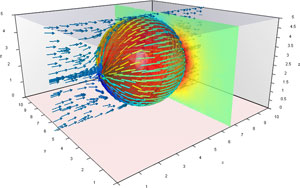|
| INFORMATION FOR Prospective Students INFORMATION Home PROJECTS Funded QUICK LINKS Optical Devices
|
Spherical SpacerIn a Pi cell there are two topologically distinct states that are stable, known as the horizontal (H) and vertical (V) state. A good explanation of the switching mechanism can be found here. In H state the directors splay, in the V state they bend. There are two mechanisms that enable transitions between the two states, order reconstruction and nucleation (sometimes called domain growth). Order reconstruction requires a large voltage to be applied, so that the central directors undergo a 90 degree change in tilt through an intermediate biaxial state. The second mechanism requires a much lower voltage and is a slower process. Depending on the applied voltage, either the H or V state are favoured. If both states coexist in a cell, then domains will either shrink or grow.
Fig.1: Director field about a spherical spacer in a Pi-Cell
When moving from the H to the V state, what is the voltage threshold to start nucleation? In a well aligned cell (with electrodes that only partially span the device) there won't be any V domains to grow, even if the voltage is high enough to favour the V state. Perhaps it is the spacers that act as a catalyst for this transition? Here, a spherical spacer in a Pi cell has been simulated, with planar degenerate anchoring on its surface. The spacer is found to facilitate the transition, but further study is required to determine the exact voltage threshold.
This page last modified 2 June, 2006 by r.james |

